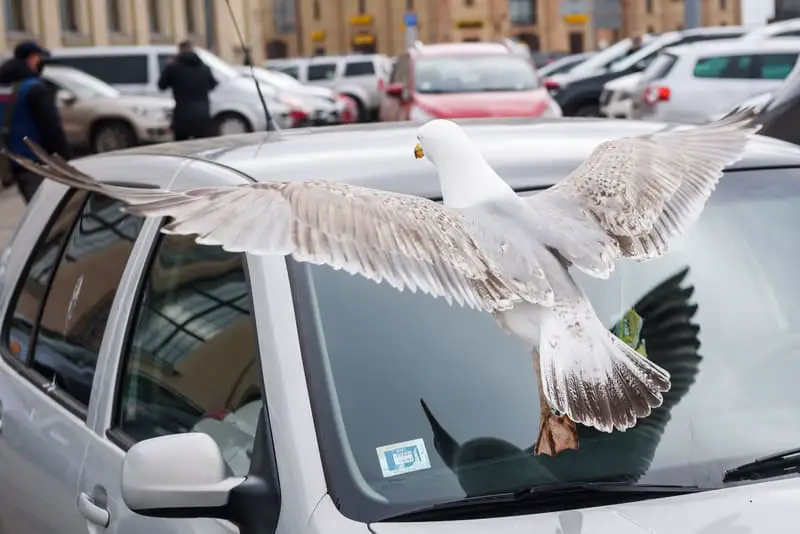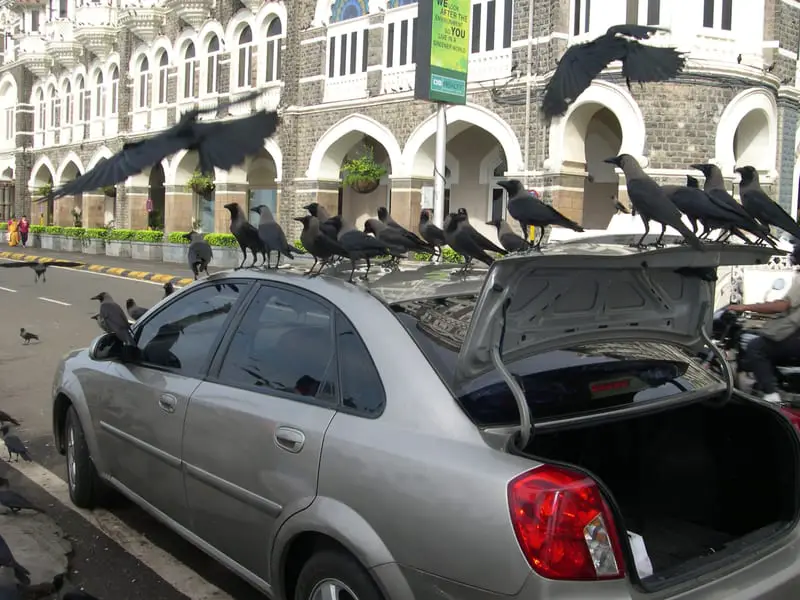
Birds flying in front of cars is an unfortunate event many drivers have experienced. You’re peacefully driving along when suddenly, out of nowhere, a bird flies directly into your windshield.
It’s enough to make anyone’s heart leap out of their chest, and the terror is so intense that it can cause you to veer off the road. Are they suicidal or playing chicken? Why on earth do birds fly in front of cars?
Birds fly in front of cars mainly because they mistake the car’s window for a body of water. The reflective surface reflecting the sky prevents birds from realizing that they are about to collide with your windshield instead of soaring into the heavens.
If you are curious why birds fly in front of cars, you’ll be happy to know that a large population of birds are not actually suicidal, and it is mostly accidental.
Why Do Birds Fly In Front Of & Crash Into Car Windows?
Sometimes, when a bird detects an approaching vehicle, it may not have enough time to avoid it, especially if it is flying toward the vehicle. In addition, during migration, birds are drawn to shiny surfaces such as car windows because they mistake them for lakes, rivers, and other bodies of water.
This frequently occurs as birds require and seek rest and recharge. The reflective surfaces of vehicles can make them difficult for birds to perceive, prompting them to fly erroneously in front of and into oncoming traffic. Due to their poor eyesight, birds and vehicles frequently collide.
Birds don’t have front-facing eyes like humans. Instead, their eyes are situated on the side of their heads, hindering their ability to judge distance and making it more challenging to detect depth.
Combine it with a fast-moving vehicle and transparent windows, and you have an accident waiting to happen. Not only do birds not know what glass is, but they also aren’t aware to check for visual clues like window frames or cracks in the glass.
Furthermore, they have a more vivid interpretation of color than we do. Birds are more inclined to fly into the glass because their reflections appear more lifelike.
Can You Avoid Birds From Crashing Into Your Window Shield?
Sadly, most birds that fly in front of cars at high speed do not survive the impact. Millions of birds die yearly in the United States because of colliding with reflective surfaces.
However, you may avoid many of these incidents by driving more defensively and slower in regions where birds are prevalent. Drivers and homeowners may dissuade birds from flying in the wrong direction by placing reflective stickers on their vehicles and home windows.
The light or sky will cause the reflective stickers to flash a blinding light to alert birds that they are heading for disaster and need to change course!
Does A Bird Fly In Front Of A Car On Purpose?

Birds are fearful when a car approaches, so they frequently flee to avoid it. However, sometimes they are oblivious that they are headed for disaster, and other times they cannot escape in time.
A typical reason why birds fly in front of cars is to evade a predator attempting to grab them.
Birds flying in front of cars may also seek to defend their nest or territory by attempting to frighten away vehicles they perceive as a threat.
If the birds attempt to protect their young, they may attempt to redirect danger away from them by flying in front of the oncoming vehicle.
The vehicle’s speed impacts the likelihood of a collision. In addition, a car’s speed influences the distance a bird must go before it can escape; hence, the larger the distance, the greater the probability of a collision.
What Can You Do After Colliding With A Bird?
Suppose you are in an area where it is safe for you to stop and exit your vehicle to check if the bird; please pull over. If it can still perch after the accident, it is okay to leave it alone; it will be able to recuperate on its own.
If you strike a bird while driving and think it may still be alive despite its injuries, you should take it to a local vet or get in touch with a wildlife rehabilitation specialist to make sure.
But if it has a serious injury, like a broken wing or leg, it must either receive quick medical treatment or be euthanized to prevent it from suffering. While you wait for assistance, you may do some things to make the bird more comfortable, such as putting it in a dark, quiet spot.
This way, the injured bird will be protected from predators and prevented from panicking and severely injuring itself. If the bird is already dead when you find it, carry it out of the way while wearing gloves (if you have some), and allow nature to take its course.
However, if the bird is making an obvious effort to escape, you should release it; if it takes flight afterward, it has recovered sufficiently to continue on its own.
The Urban Bird Foundation promotes solutions like wildlife diversion poles and underpasses to lessen the likelihood of incidents between vehicles and birds. The foundation also educates drivers to look out for birds and what they can do to prevent a collision.
Is There A Spiritual Meaning To This Phenomenon?
Some individuals believe there is a nefarious explanation for birds flying in front of cars.Whatever your particular beliefs or superstitions are, it is undeniable that witnessing a bird soar in front of your car may be a highly meaningful, powerful, and terrifying event.
According to many traditions, there are various spiritual meanings and interpretations of birds flying in front of cars. Some people think it’s a sign of good fortune and that you must interpret it as a favorable omen for the future.
Others think it’s an indication from the cosmos that you should pay close attention to your surroundings and be mindful of any signals being delivered. Some people even consider it a sign of death, in which case they advise you to get ready for a significant shift in your life.
Conclusion
The lower ground provides them with the necessary cover from predators and the opportunity to rest, refuel, and avoid starvation.
You can only be vigilant when driving in an avian-abundant neighborhood by slowing down to a speed that enables you to stop should you see a bird flying in front of your car.
